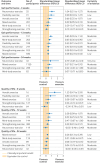Comparative efficacy and safety of exercise modalities in knee osteoarthritis: systematic review and network meta-analysis
- PMID: 41093618
- PMCID: PMC12522397
- DOI: 10.1136/bmj-2025-085242
Comparative efficacy and safety of exercise modalities in knee osteoarthritis: systematic review and network meta-analysis
Abstract
Objective: To assess the efficacy and safety of various exercise modalities as therapeutic interventions for managing knee osteoarthritis.
Design: Systematic review with network meta-analysis.
Data sources: PubMed, Embase, Cochrane Library, Web of Science, CINAHL, PsycINFO, AMED, PEDro, Scopus, ClinicalTrials.gov, ICTRP, and ClinicalTrialsRegister.eu from database inception to August 2024.
Eligibility criteria for selecting studies: Randomised controlled trials comparing different exercise modalities, including aerobic exercise, flexibility exercise, mind-body exercise, neuromotor exercise, strengthening exercise, mixed exercise, and control group for patients with knee osteoarthritis.
Main outcome measures: Primary outcomes included pain, function, gait performance, and quality of life, assessed at short term (four weeks), mid-term (12 weeks), and long term (24 weeks) follow-up. When exact time points were unavailable, data from adjacent time windows were used.
Results: 217 randomised controlled trials involving 15 684 participants were included. Moderate certainty evidence showed that, compared with the control group, aerobic exercise probably results in large improvements in pain at short term (standardised mean difference -1.10, 95% confidence interval -1.68 to -0.52) and mid-term follow-up (-1.19, -1.59 to -0.79), function at mid-term (1.78, 1.05 to 2.51), gait performance at mid-term (0.85, 0.55 to 1.14), and quality of life at short term (1.53, 0.47 to 2.59). Mind-body exercise probably results in a large increase in function at short term follow-up (0.88, 0.03 to 1.73; moderate certainty), while neuromotor exercise probably results in a large increase in gait performance at short term follow-up (1.04, 0.51 to 1.57; moderate certainty). Strengthening (0.86, 0.53 to 1.18) and mixed exercise (1.07, 0.68 to 1.46) probably result in a large increase in function at mid-term follow-up, all with moderate certainty evidence. Regarding long term follow-up, flexibility exercise may result in a large reduction in pain (-0.99, -1.63 to -0.36; low certainty); aerobic exercise may result in a large increase in function (0.87, 0.02 to 1.72, low certainty); and mixed exercise may increase function (0.56, 0.26 to 0.86; low certainty) and probably increases gait performance (0.57, 0.21 to 0.92, moderate certainty). Overall, aerobic exercise consistently showed the highest probability of being the best treatment, as reflected by surface under the cumulative ranking curve values (mean 0.72) across outcomes. The safety outcome was reported in a small proportion of studies (40 studies, 18%), and no clear differences were observed between exercise interventions and control.
Conclusions: In patients with knee osteoarthritis, aerobic exercise is likely the most beneficial exercise modality for improving pain, function, gait performance, and quality of life, with moderate certainty.
Systematic review registration: PROSPERO CRD42023469762.
© Author(s) (or their employer(s)) 2019. Re-use permitted under CC BY-NC. No commercial re-use. See rights and permissions. Published by BMJ.
Conflict of interest statement
Competing interests: All authors have completed the ICMJE uniform disclosure form at www.icmje.org/disclosure-of-interest/ and declare: support from the National Natural Science Foundation of China, Zhejiang Medicine and Health Science and Technology Project, Zhejiang Basic Public Welfare Fund, and Zhejiang University The First Affiliated Hospital of Zhejiang University School of Medicine Education Research Key Project for the submitted work; no financial relationships with any organisations that might have an interest in the submitted work in the previous three years; no other relationships or activities that could appear to have influenced the submitted work.
Figures




References
Publication types
MeSH terms
LinkOut - more resources
Full Text Sources
